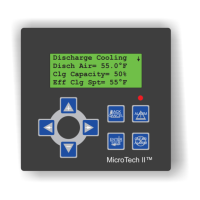OM 780-2 Page 107
Load limiting prevent the affected chillers from exceeding a certain percentage of their capacity. When no percent-of-
capacity load limit is in effect, the load limit sent to each chiller is 100%. When any one is in effect, the load limit is less
than 100%. Each chiller receives the minimum of the three percent-of-capacity load limit values that apply to it (see
below). The Chiller #X Load Limit values show the load limit the CSM is currently sending to the individual chillers.
A centrifugal chiller uses a load limit value it receives from the CSM in the same manner as a load limit value it might
generate internally:
1. Loading is inhibited when the load (%RLA) is equal to the load limit or 1% to 4% above the load limit.
2. Unloading occurs when the load is 5% or more above the load limit.
Reciprocating or screw chillers convert the load limit value it receives from the CSM into a maximum stage value.
Demand Limiting: When the CSM receives a demand-limiting signal, it sends it to all chillers associated with it. The
System Demand Limiting Load Limit variable shows the current value. If an external voltage or current is being used, the
External Demand Limiting Signal variable (Misc screen) shows the conditioned value of the input. (The CSM conditions all
analog inputs to 0–10 Vdc signals.)
Soft Load: When soft loading is enabled, it applies to the first chiller that the CSM enables. The Soft Load Limit variable
is displayed as it ramps up from its Initial Soft Load %RLA to 100%.
Load Balancing: When load balancing is enabled, it applies to all chillers that have been assigned a Load Balancing
Group #. Typically, when load balancing is used all chillers will be placed in Load Balancing Group 1 so that they are all
balanced together. The effect that load balancing is having on the system is displayed as the Load Balancing Load Limit
Group X variables displayed on the Load Limit screen for the six possible load balancing groups.
Chilled Water Distribution System Status
The CSM can maintain a constant differential pressure across the cooling loads by controlling a loop bypass valve, variable
speed cooling load pump(s), or a set of sequenced pumps. For applications that require a “lead/standby” arrangement of
two cooling load pumps, the CSM can automatically alternate the lead pump to equalize run time. To view the chilled water
distribution system status, go to the Flow screen. For more information, see Chilled Water Flow Control on page 67.
Cooling Tower Status
The CSM can maintain a common entering or leaving condenser water temperature by controlling up to 12 cooling tower
stages and a tower bypass valve. To view the cooling tower status, go to the Clg Tower Status screen. For more
information, see Cooling Tower Control on page 56.
Override of the Chiller System Manager’s Control
Local Override of a Chiller
CSM control can be overridden if you want to enable or disable a chiller locally (at the chiller unit controller); however,
this should be done only if it is absolutely necessary. If you set a chiller to local control the Chiller Off-line alarm occurs.
If you locally disable a chiller while it is enabled by the CSM, the CSM forces a stage-up, allowing the Next-ON chiller to
start immediately.
When you wish to take local control of a chiller that is running and is communicating with the CSM, the CSM will know
that the chiller is running and will not stage-up until all running chillers are fully loaded. This action helps avoid having
too much system capacity in the event of a chiller(s) running in local control, and allows the CSM to continue to control
other system components and attempt to maintain system setpoints.
There are several ways to locally enable or disable a chiller, see your chiller’s operation manual for details. When you
locally disable a chiller it cannot run for any reason. When you locally enable a chiller it runs—if the CSM is the only thing
disabling it. (For example, if there is a Fault alarm in a chiller, the chiller cannot start if you try to enable it locally.)

